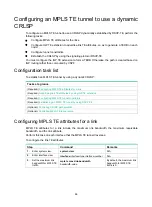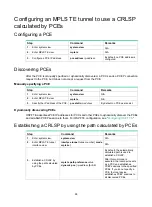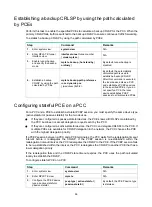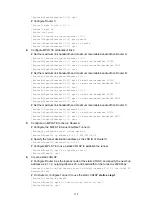
97
Step Command
Remarks
4.
Set the delegation priority of
a PCE.
pce peer
ip-address
delegation-priority
priority
By default, the delegation priority
of a PCE is 65535.
A smaller value represents a
higher priority.
5.
Set the redelegation timeout
interval.
pce redelegation-timeout
value
By default, the redelegation
timeout interval is 30 seconds.
6.
Set the CRLSP state timeout
interval.
pce state-timeout
value
By default, the CRLSP state
timeout interval is 60 seconds.
The CRLSP state timeout
interval must be greater than or
equal to the redelegation timeout
interval.
7.
Return to MPLS TE view.
quit
N/A
8.
Enter MPLS TE tunnel
interface view.
interface tunnel
tunnel-number
[
mode
mpls-te
]
N/A
9.
Enable CRLSP delegation.
mpls te delegation
By default, CRLSP delegation is
disabled.
Configuring PCEP session parameters
Step Command
Remarks
1.
Enter system view.
system-view
N/A
2.
Enter MPLS TE view.
mpls
te
N/A
3.
Set the path calculation
request timeout time.
pce
request-timeout
value
By default, the request timeout
time is 10 seconds.
4.
Set the PCEP session
deadtimer.
pce
deadtimer
value
By default, the PCEP session
deadtimer is 120 seconds.
5.
Set the keepalive interval for
PCEP sessions.
pce keepalive
interval
By default, the keepalive
interval is 30 seconds.
6.
Set the minimum acceptable
keepalive interval and the
maximum number of allowed
unknown messages received
from the peer.
pce tolerance
{
min-keepalive
value
|
max-unknown-messages
value
}
By default, the minimum
acceptable keepalive interval is
10 seconds, and the maximum
number of allowed unknown
messages in a minute is 5.
Configuring traffic forwarding
Perform the tasks in this section on the ingress node of the MPLS TE tunnel.
Configuring static routing to direct traffic to an MPLS TE
tunnel
Step Command
Remarks
1.
Enter system view.
system-view
N/A
















































